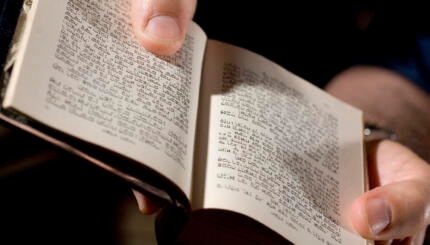Rabbi Millgram’s thorough but critical survey of the influences of the Kabbalah (mysticism) of the Zohar and later Lurianic Kabbalah on Jewish liturgy is reprinted with permission from Jewish Worship, published by the Jewish Publication Society.
In addition to enriching the siddur [prayer book] with prayers and hymns of superb quality, the kabbalists took the ultimate step of transforming all prayer into an esoteric exercise and the whole siddur into a kabbalistic tract. The central objective of prayer was to effect the union of the Shekhinah [God’s presence or indwelling, understood as a feminine aspect of the divine] and the Holy One, blessed be He, or to restore the divine perfection that was damaged by sin.
The process of prayer consisted of concentration, or kavannah, on the esoteric significance of each prayer and especially on the divine names in it. This kind of kavannah, said the kabbalists, can bring unity into the divine essence and thus achieve the redemption of Israel.
In order that the mystic may be ever aware of this central aim and properly apply mystic kavannah to his prayers, each prayer was preceded by preparatory introductions. From the point of view of religious inwardness and piety, this kabbalistic use of kavannah represents a considerable decline in the concept as used in the Talmud and in the Jewish philosophical and ethical literature of the Middle Ages. Instead of being a pious concentration on prayer, a pouring out of one’s heart before God, kavannah was turned into a concentration of mystic intentions aimed at affecting the cosmic order and thus insuring divine aid.
With your help, My Jewish Learning can provide endless opportunities for learning, connection and discovery.
Mystical Meanings and Meditations
The kabbalists not only transformed their own prayer into a mystic ritual requiring deep concentration on various aspects of their esoteric system, but also influenced the official liturgy of the synagogue. Although they did not alter traditional prayers, they read into them many esoteric doctrines. These new mystic meanings gained wide acceptance even among the uninitiated. They penetrated the liturgy with hardly any resistance.
In order to direct the worshiper’s thoughts to the "real" meaning of the prayers, the kabbalists provided introductory meditations, especially before the various rituals of the liturgy. Thus we find an introductory prayer which is still recited before putting on the prayer shawl [tallit] for the morning service: "Even as I cover myself with the tallit in this world, so may my soul deserve to be clothed with a beautiful tallit in the world to come in the Garden of Eden. Amen."
The kabbalistic content of this prayer is unmistakable. Its mystical symbolism of the soul wrapped in a tallit in the world to come survived even after the modernists had applied their fine comb to the prayer book and eliminated almost all the kabbalistic elements.
While wrapping oneself in the tallit one recites four biblical verses:
"How precious is Thy lovingkindness, O God!
And the children of men take refuge in the shadow of Thy wings.
They are abundantly satisfied with the fatness of Thy house;
And Thou makest them drink of the river of Thy pleasures.
For with Thee is the fountain of life;
In Thy light do we see light.
O continue Thy lovingkindness unto them that know Thee;
And righteousness to the upright in heart." (Psalms 36:8-11)
And while putting on the tefillin [phylacteries] two biblical verses are recited;
"And I will betroth thee unto Me forever;
Yea, I will betroth thee unto Me in righteousness and in justice,
And in lovingkindness, and in compassion.
And I will betroth thee unto me in faithfulness;
And thou shalt know the Lord." (Hosea 2:21-22)
The selections are obviously not kabbalistic compositions. But the mystics saw in the biblical figures of speech kabbalistic hints, such as taking "refuge in the shadow of God’s wings," "the fountain of life," "them that know Thee," and of course the obvious kabbalistic doctrine of the "betrothal" of God to his "bride," Israel. These verses were introduced into the ritual of putting on tallit and tefillin by a 17th-century kabbalist, Rabbi Nathan Shapira, and they are still part of the ritual.
Uniting the Holy One and the Shekhinah
Most of the introductory meditations initiated by the kabbalists do not rely on mystic hints. They speak clearly of the central goal of the prayer–"to effect the union of the Holy One, blessed be He, and the Shekhinah [God’s presence–a feminine aspect of God, in the view of many kabbalists]." Thus the meditation read before putting on the tallitstarts off with this typical declaration:
"I am hereby ready to put on the fringed tallit in accordance with the halakhah [law] as the Lord our God commanded us in His holy Torah… in order to effect the union of the Holy One, blessed be he, and the Shekhinah in reverence and love… and to unite the first two letters and the last two letters of the Tetragrammaton [God’s four-letter name] in a complete union."
Most modern prayer books have eliminated this meditation, along with most other mystic prayers. The Sephardim [Jews of Iberian ancestry], however, still use them. Indeed, no modern censorship has been applied to the Sephardic prayer book. It is therefore replete with mystic symbolism and kabbalistic prayers.
Kabbalistic meditations penetrated into the services of the entire prayer cycle. Thus we find a mystic meditation before the sounding of the shofar [ram’s horn] during the Rosh Hashanah services. In addition to the usual formula indicating that the intention of the ritual is to "effect the union of the Holy One, blessed be He, and the Shekhinah," there is an allusion to the concept of a divine court with a celestial "district attorney" in the person of Satan. When the shofar is sounded, its shrill sounds ascend to heaven and confuse Satan, thus permitting God’s attribute of mercy to prevail. This mystic concept is spelled out in the acrostic of the biblical verses recited on that occasion. The acrostic reads "k’ra satan" ("destroy Satan").
Still another example of the kabbalistic penetration into the yearly cycle of the synagogue prayers is the practice of reciting the 13 Divine Attributes [Exodus 34:6-7a] before taking the Torah from the ark during the major festivals. This is followed by a silent prayer: "O Lord of the universe, fulfill for good the desires of our heart." Both the recital of the 13 Divine Attributes and the prayer after it are of kabbalistic origin. Their source is a 17th-century kabbalistic work, entitled Sha’arei Tziyyon ("The Gates of Zion"), by Nathan Hannover. Because the prayer aroused opposition on the part of the modernists, some modern prayer books omit the prayer, though they retain the 13 Divine Attributes. The Sephardic prayer books, of course, contain the full prayer with all its kabbalistic formulas.
Kabbalistic Prayers
"The mystics," says Israel Abrahams [in his Jewish Life in the Middle Ages, p. 29], "were the best prayer writers of the Middle Ages, and one would seek in vain for a Jewish Thomas a Kempis [medieval Catholic priest and writer] outside the ranks of the mystics." The prayers composed by the kabbalists are often not recognized as mystic prayers, because the mystical ideas contained in them are usually stated in simple liturgic style, without recourse to the esoteric terminology of the Kabbalah.
To be sure, this rendered their doctrines somewhat inexact. But the prayers benefited from the avoidance of controversy. They easily lent themselves to reinterpretation and thus became acceptable to all elements of the community.
A good example is the kabbalistic prayer recited before the Torah is removed from the ark. This prayer is known by its initial words as B’rikh Sh’mei ("Blessed be the name"). The prayer is taken verbatim from the Zohar and was introduced into the liturgy by [the 16th century mystic] Rabbi Isaac Luria. Its wide acceptance in modern synagogues, despite its kabbalistic origin, is due to its genuine liturgical quality, which is evident even in translation:
"Blessed be the name of the Sovereign of the universe. Blessed be Thy crown and Thy abiding-place. Let Thy favor rest with Thy people Israel forever: show them the redemption of Thy right hand in Thy holy temple…. Thou art He that feedeth and sustaineth all; Thou art He that ruleth over kings, for dominion is Thine.
"I am the servant of the Holy One, blessed be He, before whom and before whose glorious Torah I prostrate myself at all times: not in man do I put my trust, nor upon any angel do I rely, but upon the God of heaven, who is the God of truth, and whose Torah is truth, and whose prophets are prophets of truth, and who aboundeth in deeds of goodness and truth. In Him do I put my trust, and unto His holy and glorious name do I utter praises.
"May it be Thy will to open my heart unto Thy Torah, and to fulfill the wishes of my heart and of the hearts of Thy people Israel for good, for life, and for peace. Amen."
ark
Pronounced: ark, Origin: English, the place in the synagogue where the Torah scrolls are stored, also known as the aron kodesh, or holy cabinet.
Kabbalah
Pronounced: kah-bah-LAH, sometimes kuh-BAHL-uh, Origin: Hebrew, Jewish mysticism.
Rosh Hashanah
Pronounced: roshe hah-SHAH-nah, also roshe ha-shah-NAH, Origin: Hebrew, the Jewish new year.
Sephardic
Pronounced: seh-FAR-dik, Origin: Hebrew, describing Jews descending from the Jews of Spain.
shofar
Pronounced: sho-FAR or SHO-far, Origin: Hebrew, a ram’s horn that is sounded during the month of Elul, on Rosh Hashanah, and on Yom Kippur. It is mentioned numerous times in the Bible, in reference to its ceremonial use in the Temple and to its function as a signal-horn of war.
siddur
Pronounced: SIDD-ur or seeDORE, Origin: Hebrew, prayerbook.
tallit
Pronounced: tah-LEET or TAH-liss, Origin: Hebrew, prayer shawl.
Talmud
Pronounced: TALL-mud, Origin: Hebrew, the set of teachings and commentaries on the Torah that form the basis for Jewish law. Comprised of the Mishnah and the Gemara, it contains the opinions of thousands of rabbis from different periods in Jewish history.
tefillin
Pronounced: tuh-FILL-in (short i in both fill and in), Origin: Hebrew, phylacteries. These are the small boxes containing the words of the Shema that are traditionally wrapped around one's head and arm during morning prayers.
Torah
Pronunced: TORE-uh, Origin: Hebrew, the Five Books of Moses.
Zohar
Pronounced: ZOE-har, Origin: Aramaic, a Torah commentary and foundational text of Jewish mysticism.


